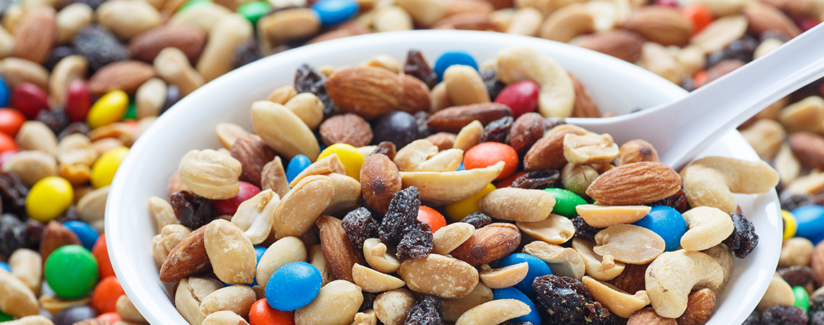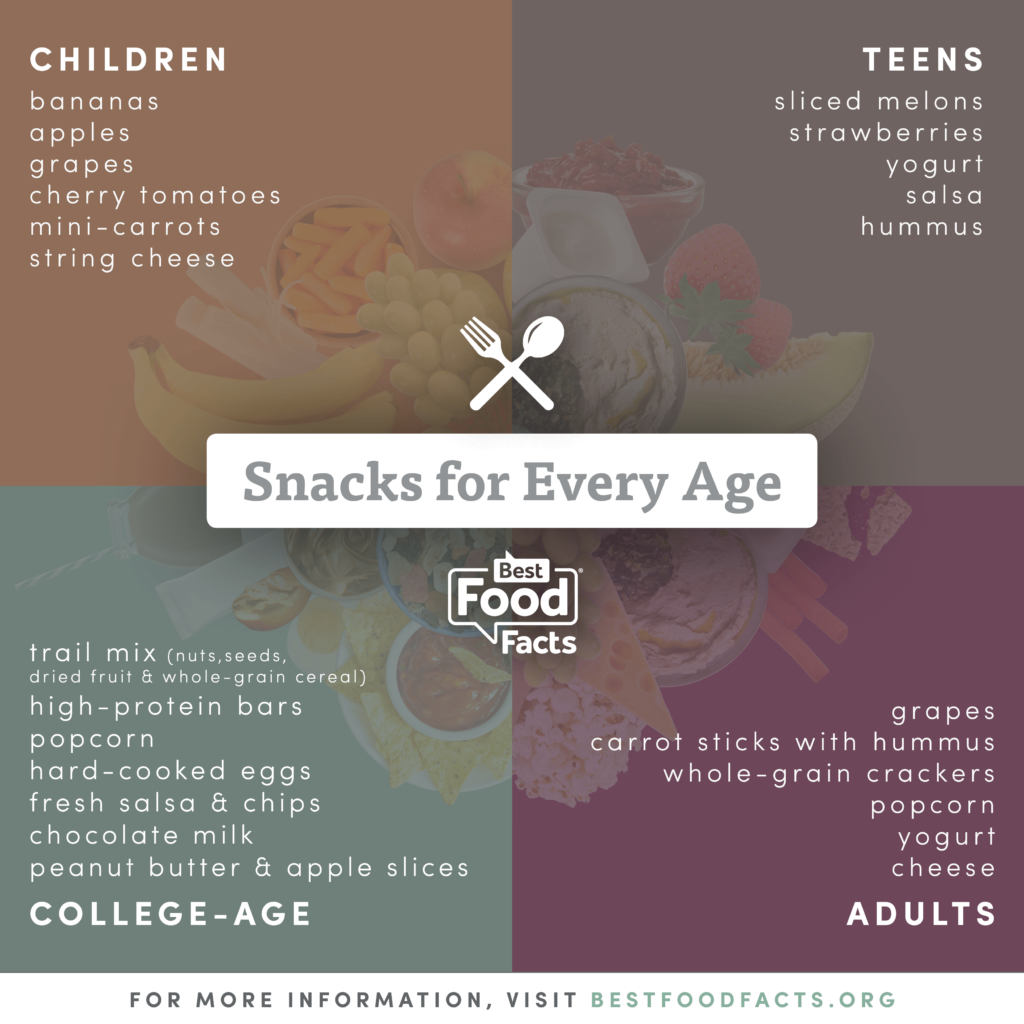
Healthy Snack Ideas for Kids of All Ages
08/29/2017
It’s three o’clock and your stomach starts to rumble. You ate lunch two hours ago, but dinner isn’t for a few more hours. So, what do you do? Grab a snack. We’ve covered how many calories should be in a snack and what constitutes a healthy snack, but we wanted to dig a little deeper since school is back in session.
How many snacks should a child have a day? How about high school and college-aged students? We reached out to expert Dr. Julie Garden-Robinson, Ph.D., R.D., L.R.D., Food and Nutrition Specialist, North Dakota State University Extension Service, to find out how to better distribute (and pick!) snacks for people of all ages.
Are there any health benefits for snacks?
Dr. Garden-Robinson: “Well-timed snacks can prevent overeating and also can fill nutrition gaps. For example, if you assess your own diet and determine you aren’t eating the recommended 4 ½ cups (or more) of fruits and vegetables, well-chosen snacks can help you meet your needs. Fruits and vegetables provide vitamins, minerals, fiber and disease-fighting phytochemicals, which are natural plant chemicals.
“Instead of going to the candy vending machine at work, you might find that a handful of grapes mid-morning and carrot sticks with hummus in mid-afternoon quench your appetite. If you are not getting enough whole grains, have whole-grain crackers or popcorn for a quick snack. Perhaps you are not consuming enough calcium, so calcium-rich snacks such as yogurt, cheese or calcium-fortified cereal might fill your calcium needs.”
What are some snacks that should be avoided? Are there any?
Dr. Garden-Robinson: “Sugary and salty snacks sometimes compete for our attention, even when we have the best nutrition intentions. Try to quench your appetite with nutrient-rich foods. If you occasionally choose ‘less-healthful’ snacks that might be high in calories, sodium and/or trans fat, have a small portion. Read and compare the nutrition labels, put one serving (based on what the package says) in a container, and savor your ‘treat’ slowly without distractions. Avoid eating food directly out of the box or package, because people eat more than one serving if eaten directly from the package.“
How many snacks should a child have a day?
Dr. Garden-Robinson: “On average, children need three meals and two or even three small snacks per day. Children often cannot eat enough at mealtimes to meet their energy needs, so well-timed snacks can help prevent them from becoming overly hungry. However, keep in mind that continual snacking may lead to excess calorie intake that could contribute to overweight or obesity. Many experts suggest keeping snacks in the 100- to 200-calorie range.”
“Snacks are an important part of the day for school-age children, because kids need to fuel their bodies and brains. In addition to meals, children need healthful snacks to enjoy mid-morning at school, another snack right after school and perhaps, a bedtime snack.”
If your child is more active, does that mean that they should have a higher calorie intake?
Dr. Garden-Robinson “Level of physical activity, age and gender are factors that play a role in how many calories that any of us need from childhood throughout adulthood. Children who are more active usually need additional calories, but the increase in calorie needs may not be as much as we may think. For example, an 8-year-old female who is ‘sedentary’ may need about 1,200 calories, while her ‘moderately active’ peer might need about 1,400 to 1,600 calories and another ‘active’ female peer may need up to 1,800 calories.”
What are some healthy, and easy, snacks that you recommend for families on the go?
Dr. Garden-Robinson: “Parents will want to think about their children’s food likes and dislikes, and also be a role model for healthful eating. Unfortunately, the majority of U.S. children do not meet the daily recommendations for fruits, vegetables or whole grains, so consider foods from these groups as go-to snacks. Keep in mind potential food allergies and choking hazards as you plan snacks for children, too. Be sure the pieces are the proper size and texture/hardness for children to safely eat.
For example, bananas, apples, grapes, cherry tomatoes and mini-carrots are portable snacks that require minimal preparation. Parents can make their own cereal snack mixes from their child’s favorite whole-grain cereal, dried fruit such as cranberries or raisins and/or nuts, then place in snack-size zipper-top plastic bags. From the dairy group, consider string cheese (low-fat mozzarella) and whole-grain crackers as a protein-rich fun snack with a little crunch. See Make Your Own Snack Mixes and Nutritious After School Snacks for easy snack ideas and recipes.”
For middle schoolers and high schoolers, what should they be consuming? How many calories a day? Should they be eating more or less snacks?
Dr. Garden-Robinson: “Kids in middle school and high school are still growing and need adequate nutrition and an occasional snack to fuel their development. Most nutrition experts suggest three meals and one snack for older children, but that will vary depending on how physically active the teens are and whether they are going through a growth spurt. For example, a 14-year-old sedentary boy may need 2,200 calories while his active counterpart may need 3,200 calories.
“Teenagers often exercise more independence in their food choices, and they may enjoy making their own snacks. Parents should be sure to have healthful snacks and ingredients readily available in their refrigerator, freezer and/or cupboard. Make the home environment conducive to healthful choices. For example, have a bowl of bananas on the counter, and sliced melon, strawberries, yogurt, carrots and broccoli florets in the fridge. Have frozen fruit and Greek yogurt available for smoothies, and whole-grain tortillas, shredded cheese and salsa ready to roll and microwave for a quick warm snack. Hummus (made from protein-rich chickpeas) and whole-grain crackers also make a tasty snack.
“Older kids may be more adventuresome eaters, and they may enjoy preparing their own snacks. Be sure that the budding chefs know about kitchen safety, including proper handwashing as well as safe use of a microwave oven, toaster and/or oven. Set rules about what they are allowed and not allowed to do.”
For a college-aged student, what are some snacks that they could keep in their backpack or in their dorm room for on the go that would be easy and healthy?
Dr. Garden-Robinson: “Trail mix with nuts, seeds, dried fruit and whole-grain cereal are excellent appetite-quenching, backpack-friendly, shelf-stable snacks for students on the go. Many students enjoy high-protein ‘granola-type’ bars. College students often are very creative when it comes to food. Most college students have mini-refrigerators or microwave ovens, so having these options available opens up a wide range of possibilities for snacks, including popcorn, Greek yogurt with fruit, hard-cooked eggs and fresh salsa and chips. Even a high-protein beverage, such as chocolate milk, can be considered a snack. (In fact, research has shown chocolate milk to be a good sports-recovery beverage.) Peanut butter or other nut butter on apple slices provide a tasty study break, too!”
When it comes to snacking, there are proven health benefits. Consider calorie and nutrition needs to have a perfect snack at any age. Here are some ideas.



























